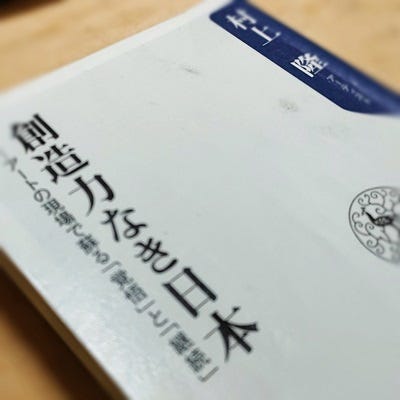<read> Takashi Murakami "Sozoryoku naki Nihon" (JP)
Japan's leading artist Takashi Murakami has written several books. Today, let's introduce his book published only in Japanese with Japanese Chisai!
The Exhibition "Takashi Murakami Mononoke Kyoto" will start on February 3rd, 2024, at the Kyoto Museum of Art in Japan. Yes, that famous Japanese artist Murakami! At a press conference held last November, I referred to his words "last in Japan" and wrote the article on the Japanese news website. Yes, Murakami's words always hit the nail on the head. So today, I would like to share and consider Murakami's book, “Sozoryoku naki Nihon 創造力なき日本”.
Book cover of Takashi Murakami “Sozoryoku naki Nihon 創造力なき日本”
If you are familiar with Japanese and Asian art from 2000 onwards, you probably know a book called "SuperFlat" written by Murakami. He also writes books, and there are many English versions. This book, “Sozoryoku naki Nihon”, title means “Japan without Creativity” in English and published in 2012. He wrote in Japanese language = published only in Japan = for just Japanese people.
Let's look at the table of contents.
Chapter 1 --- Living in the Art World
Chapter 2 --- Training and Work Style for Success
Chapter 3 --- Charting Strategy for Winning
Chapter 4 --- How to Raise Extremely People In the Era of Fair Argument
Chapter 5 --- The Art World as Art Industry
It is about 200 pages long, but it has a lot of content! And it may seem strange to people outside of Japan(ese). The year before the book was published in 2012, Japan experienced the Great East Japan Earthquake in 2011. Many Japanese stopped because of anxiety. Then many "mental training" books increased, maybe this book is one of them. Rather than talking about art world or artworks, it is about how to nurture staff and how to live in the art world.
For example, if you want to live in the art world, you need to move toward your target rather than just create artworks. Or, if you continue to think of art as your job, strategy is important, not pursuing your dreams. Like them, there are many such things in this book.
I don't know how much this book sold, and how much Murakami's advice reached the Japanese? In 2024, more than 10 years after its publication, there are no Japanese artists known to the world except Murakami (and Yoshitomo Nara). As this book title suggests, Japan has NO LONGER creative power. I am not artist, but I read this book again and learn deeply. Thank you so much, Murakami!





